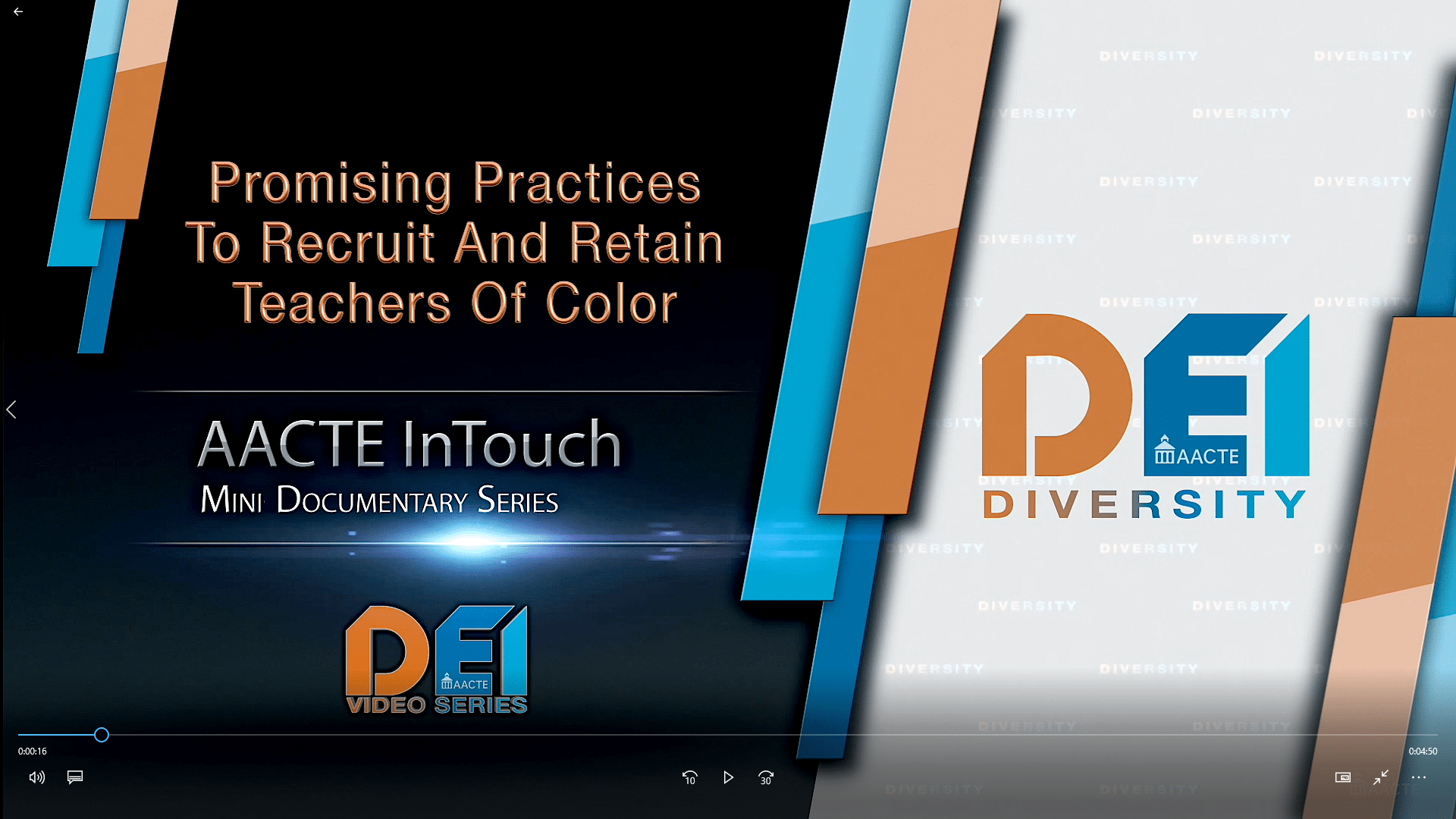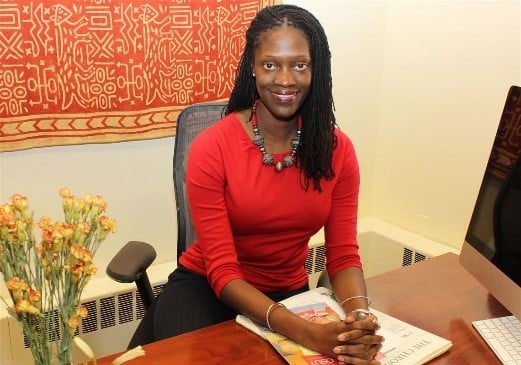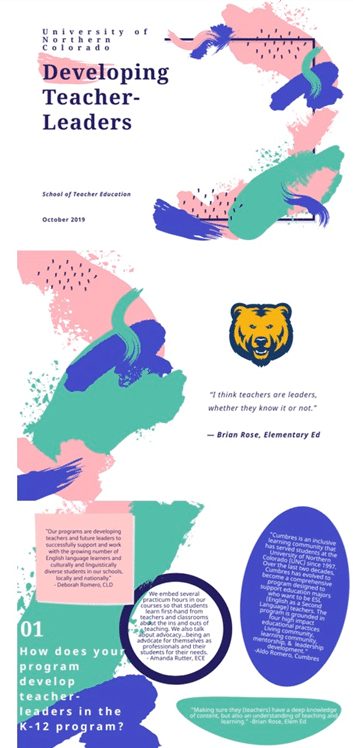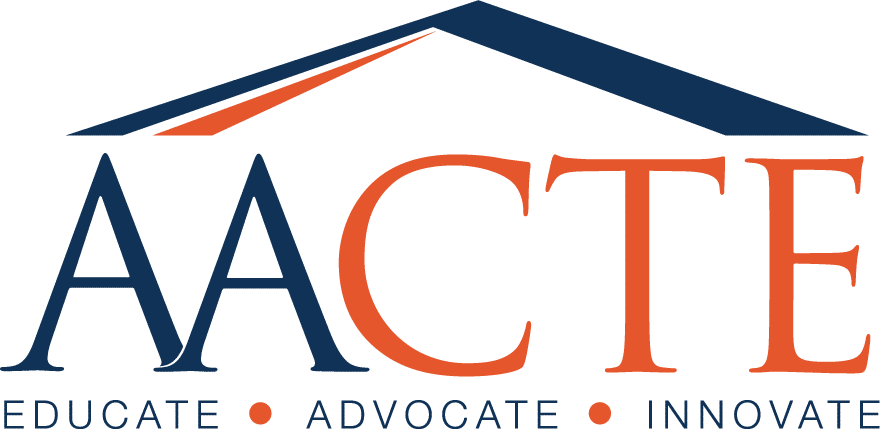03 Dec2019
AACTE’s DEI Video Highlights Promising Practices to Recruit and Retain Teachers of Color
By Jerrica Thurman
Ed Prep Matters features the “Revolutionizing Education” column to spotlight the many ways AACTE, member institutions, and partners are pioneering leading-edge research, models, strategies and programs that focus on the three core values outlined in the current AACTE strategic plan: Diversity, Equity, and Inclusion; Quality and impact; and Inquiry and Innovation.

AACTE is focusing on ways that education leaders and colleges of education can employ to address the national shortage of educators of color more effectively. “AACTE’s new mission is to revolutionize education for all learners,” said AACTE Board Chair Kim Metcalf, dean of the college of education at the University of Nevada Las Vegas. “We are shifting our efforts to provide members support and encouragement to be innovative in ways that address not just today’s needs in their local communities, but the needs that those communities will have in years to come.”
03 Dec2019
By Michael Dantley

Why are schools still segregated in 2019? The answer to this question is a complicated one. One with roots deep in the history of our educational system. The surface answer has to do with the fact that racist curricula and prejudice within our society still exist. Where you live determines where you go to school. Many times, the poorer, minority students live in lower income neighborhoods. And as children become racially isolated, it then trickles into our schools, resulting in segregation.
In fact, segregation is even evident in schools that are racially diverse. You’ll notice that most students in advanced placement classes are Caucasian or Asian. Who do we see in remedial classes? We see African American students, particularly African American males. Even with a diverse student population, the evidence of systemic segregation is scarily rampant. The deep vestiges of racism and segregation subtly permeate through our schools and it sets dangerous precedents.
27 Nov2019
By Katrina Norfleet
 In an article that originally appeared in The Chronicle of Higher Education, author Julia Piper explores the experiences of Valarie Kinlock as the first black female dean at the University of Pittsburgh. Kinlock, the dean of the School of Education, didn’t realize she was the first when she was hired. Since her appointment, she has gone from being the only black female dean at the university to being one of two. She emphasizes the need for more conversations about racism as more people of color progress to leadership roles.
In an article that originally appeared in The Chronicle of Higher Education, author Julia Piper explores the experiences of Valarie Kinlock as the first black female dean at the University of Pittsburgh. Kinlock, the dean of the School of Education, didn’t realize she was the first when she was hired. Since her appointment, she has gone from being the only black female dean at the university to being one of two. She emphasizes the need for more conversations about racism as more people of color progress to leadership roles.
The article highlights data on the gender of university deans, including the AACTE report published last year: Colleges of Education: A National Portrait. According to the AACTE research, the “average” dean of a college of education is a white woman.
22 Nov2019
By Katrina Norfleet
Ed Prep Matters features the “Revolutionizing Education” column to spotlight the many ways AACTE, member institutions, and partners are pioneering leading-edge research, models, strategies and programs that focus on the three core values outlined in the current AACTE strategic plan: Diversity, Equity, and Inclusion; Quality and impact; and Inquiry and Innovation.

AACTE recently released its 2020-2023 Strategic Plan, which includes a new vision statement: AACTE, its members, and partners collaborate to revolutionize education for all learners. Aligned with the new strategic plan, Ed Prep Matters is launching a new column called Revolutionizing Education to showcase the many ways the Association and member institutions are moving beyond traditional perspectives and are pioneering positive change in educator preparation.
The Revolutionizing Education column is an opportunity for member institutions and partners to share the leading-edge research, models, strategies, programs, and initiatives that focus on the three core values outlined in the new AACTE strategic plan:
- Diversity, Equity, and Inclusion
- Quality and impact
- Inquiry and Innovation
14 Nov2019
By Ward Cummings

This article, written by AACTE Director of Government Relations K. Ward Cummings, originally appeared in the Daily News Opinion section and is reprinted with permission.
The civil rights leader Malcolm X once famously said that the most segregated hour in American life is high noon on Sunday. If he were alive today, he might also include those weekday hours between 9 a.m. and 3 p.m. when our children are in school.
This past May was the 65th anniversary of Brown vs. Board of Education. The occasion inspired numerous panel discussions, seminars and reports about how much or how little the state of education has changed in the last half-century. Sadly, considerable attention also was paid to the subject of how segregated American schools remain 65 years later.
07 Nov2019
By Leslie T. Fenwick
 This article, written by AACTE Dean of Residence Leslie T. Fenwick, originally appeared in the Washington Post Valerie Strauss column and is reprinted with permission.
This article, written by AACTE Dean of Residence Leslie T. Fenwick, originally appeared in the Washington Post Valerie Strauss column and is reprinted with permission.
“The Problem We All Live With” is the title of the famed Norman Rockwell painting inspired by the story of Ruby Bridges and school integration. In 1964, Rockwell created the painting for the 10th anniversary of the Brown v. Board of Education legal decision that declared state laws establishing separate public schools for black and white students were unconstitutional. The subject of Rockwell’s painting was inspired by Ruby Bridges, who was just 6 years old (born four months after the May 1954 Brown decision) when she integrated the all-white William Frantz Elementary School in New Orleans.
The rabid violence hurled at young Ruby (mainly that day by white women on the scene) is represented in Rockwell’s painting by a racial slur, the letters KKK and a splattered tomato — all appearing on the wall behind Ruby as she marches forward. Despite this terrorism, innocent Ruby walks close on the heels of the front two guards into an undeterrable future. The painting is triumphant. Ruby’s right to attend an American public school unshackled by segregation was ensured by the federal government and, that day, warranted the protection of U.S. federal marshals.
06 Nov2019
By Jerrica Thurman

AACTE is excited to announce the release of its new video series on Diversity, Equity and Inclusion in educator preparation. The videos address a wide variety of topics ranging from promising practices for recruiting and retaining teachers of color, to the importance of culturally relevant teaching for growing the special education teacher pipeline, and also promoting equal access to quality teachers, just to name a few.
The video series exemplifies the Association’s new strategic priority to promote diversity, equity and inclusion. AACTE and its members value the diversity of students, their families, and educators; equity in access to high quality instructional environments; and the inclusion of all students, defined as access and opportunity in PK-20 classrooms.
01 Nov2019
By Preston Thorne
 This op-ed article originally appeared in The State and is reprinted with permission.
This op-ed article originally appeared in The State and is reprinted with permission.
I was wasting time on Twitter when I came across a post that stopped me mid-scroll. The original post posed a question: How many black male educators did you have in kindergarten through 12th grade.
One of my former students chimed in with a shocking number: 1…Coach Thorne.
That’s me; that’s who I was. I taught social studies at Blythewood High School for 11 years and was an assistant football coach.
At first glance, the number 1 seems to be an indictment and a referendum on what we in education circles have known forever—we need more black men in the classroom. But upon further inspection, with a little critical analysis, I believe there is power in one.
Statistics tell us that having just one African American teacher in elementary school reduces drop-out rates among black boys by nearly 40% and increases their recognition as gifted students.
But stats don’t tell the story.
31 Oct2019
By Cecelia Monto

The need to diversify the teaching workforce is well documented (Darling-Hammond, 2010). Student demographics across the United States have significantly changed in the last 20 years, with particular increases in bilingual and Hispanic student populations (Aud, Hussar, Kena, Bianco, Frohlich, Kemp, &Tahan, 2011). However, the teaching workforce has not reflected the shift in student demographics, and a growing gap has emerged between the racial and ethnic backgrounds of students and teachers. Because community colleges serve a high percentage of diverse students, a community college pathway into teaching represents a promising approach for increasing the diversity of the teaching workforce.
31 Oct2019
By Jingzi Huang

The University of Northern Colorado (UNC) holds a long-standing tradition of developing its future teachers as leaders in the community. Since 1889, the school has taken pride in its commitment to teacher excellence. However, never content to settle, the faculty and staff that constitute UNC’s School of Teacher Education (STE) continue to encourage the next generation of teachers to blaze their own trails and inspire change in their communities.
In addition to delivering the widest array of licensure programs in Colorado to meet the state and national needs, STE at UNC offers specialized licensure and endorsement opportunities within its diversity framework. Programs such as the Cumbres Teacher Preparation Program—an inclusive learning community that has served students at UNC since 1997—and Culturally and Linguistically Diverse (CLD) and Teaching English to Speakers of Other Languages (TESOL) endorsements urge teachers to utilize culturally responsive curriculum in the classroom.
Aldo Romero, the director of Cumbres, says the Cumbres program “is a co-curricular, student support services and scholarship program. Over the last two decades, Cumbres has evolved to become a comprehensive program designed to support education majors who want to be English as a Second Language teachers (ESL). The program is grounded in four high impact educational practices: living community, learning community, mentorship, and leadership development.” He also says that Cumbres educators are constantly “acquiring new knowledge and skills to support their development to become not only excellent teachers but also exceptional leaders in K-12 settings.”
24 Oct2019
By Ryan Carrillo
The Teacher Diversity Research Award is presented by the AACTE Diversified Teacher Workforce (DTW) Topical Action Group (TAG) for outstanding research and advocacy related to various policies, practices, programs, pedagogies, systems, and/or institutions for the purpose of advancing teacher diversity. The research leadership embodied by the recipient of this award reflects the DTW TAG’s mission and goals and advances our current understanding of how to diversify our teacher workforce to enhance educational opportunities for all students. Recipients of this award have published articles, books, and /or created professional development services or products that function as tools and resources to help facilitate teacher education programs, leaders, and/or policymakers in strategic planning and project implementation that actualize the goal of creating a diverse teacher workforce in the 21st century. In addition, recipients of this award will evidence a service-minded disposition toward addressing teacher diversity in research and practice through their leadership and participation in the local community, school, and/or grassroots service efforts.
In recognition and honor of this important work, the recipient of this award will receive a $1,000 honorarium and be invited to give a featured research talk at our 2020 DTW Institute at the 2020 AACTE Annual Meeting in Atlanta, GA. Also, the recipient of the award must participate in the 2020 DTW Teacher Diversity Research Award Selection Committee and /or contribute to the planning of the 2021 DTW Institute.
In order to nominate someone (self-nominations accepted) for the DTW Teacher Diversity Research Award, email the following documents with “Teacher Diversity Research Award” as the subject line to Marvin Lynn at coe-dean@pdx.edu by December 15, 2019:
18 Oct2019
By Lynn M. Gangone
Last month, the AACTE Board of Directors approved the Association’s new strategic priorities. Along with our new vision, mission, and core values, these priorities will guide AACTE’s work. Our values of diversity, equity, and inclusion; inquiry and innovation; and quality and impact will permeate all of our initiatives. Please take a few minutes to watch the video (or read the transcript) to learn more.
AACTE collaborates with its members and partners to revolutionize education for all learners. Learn more at aacte.org. And stay tuned for our November Board of Directors elections!
P.S. Secure your spot for AACTE’s 2020 Annual Meeting at the early bird rate by October 30!
15 Oct2019
By Justin Mattingly

This article and photo originally appeared in the Richmond Times-Dispatch and are reprinted with permission.
Calvin Sorrell was the only black male teacher Rodney Robinson had.
He taught in King William County for three dozen years and remembers Robinson as knowledgeable, caring and talented. Robinson was shy, though, lacking many teachers who looked like him.
“The potential was there; he just had to come out a little bit,” Sorrell said. “I knew he always had the ability.”
Robinson looked up to the one black male teacher he did have, who taught him how to play the trombone, baritone and tuba. He became a teacher to give students the teacher he had only once, among other reasons.
“Kids need positive role models,” Sorrell said of being a black male teacher. “It gives them someone to look up to, and he was no exception.”
It surprised him when Robinson became a teacher, but knowing Robinson now, a man driven to improve teacher diversity while getting to know his students, Sorrell was not shocked to find out last week that Robinson is the National Teacher of the Year.
15 Oct2019
By Davis Dixon and Ashley Griffin

A majority of the nation’s public school students are students of color, but less than 20% of teachers are teachers of color—and only 2% are Black men. While more teachers of color are entering the classroom, data reveal that educators of color are also leaving at higher rates than their peers. To show the root cause of this problem and to identify solutions, The Education Trust and Teach Plus today jointly released new research that examines the challenges teachers of color face and documents the experiences of staff in schools that deliberately work to retain faculty of color.
If You Listen, We Will Stay: Why Teachers of Color Leave and How to Disrupt Teacher Turnover comprises authentic narratives of teachers of color and successful school leaders. For this report, researchers conducted focus groups with teachers who identify as Black or Latino who talked about their experiences in the workforce and what schools, districts, and states could do to keep them in the field. Researchers also conducted case studies in schools and districts that were selected for their intentionality around retaining teachers of color.
High-Level Findings
In the focus groups, five themes emerged, highlighting the challenges that teachers of color face in the workforce and the reasons many of them fall out of teaching: (1) experiencing an antagonistic school culture; (2) feeling undervalued; (3) being deprived of agency and autonomy; (4) navigating unfavorable working conditions; and (5) bearing the high cost of being a teacher of color.
15 Oct2019
By Gilda Martinez-Alba

This article and photo originally appeared on the Engage TU-Towson University blog and are reprinted with permission.
The Towson Univerity (TU) Teacher Scholars Summer Institute premiered this summer (July 15–18) in an effort to recruit high school students into teaching. This was also an effort to work more closely with our Teacher Academy of Maryland (TAM) program.
One of our main goals was to assist in recruiting more underrepresented students into the field of education, which is predominantly composed of white females across the nation. Conversely, about half of K–12 students are from diverse backgrounds and/or are male. We are also facing a critical shortage of teachers in the U.S., and Maryland is facing the same issues. In fact, all 24 counties in Maryland are experiencing a shortage of teachers based on the last Maryland State Department of Education Staffing Report. In addition, enrollments at TU and across the nation have been declining in education programs. Therefore, we were piloting this program to help create a pipeline of more teachers, as well as more diversity among teachers.









 In an article that originally appeared in The Chronicle of Higher Education, author Julia Piper explores the experiences of Valarie Kinlock as the first black female dean at the University of Pittsburgh. Kinlock, the dean of the School of Education, didn’t realize she was the first when she was hired. Since her appointment, she has gone from being the only black female dean at the university to being one of two. She emphasizes the need for more conversations about racism as more people of color progress to leadership roles.
In an article that originally appeared in The Chronicle of Higher Education, author Julia Piper explores the experiences of Valarie Kinlock as the first black female dean at the University of Pittsburgh. Kinlock, the dean of the School of Education, didn’t realize she was the first when she was hired. Since her appointment, she has gone from being the only black female dean at the university to being one of two. She emphasizes the need for more conversations about racism as more people of color progress to leadership roles.

 This article, written by AACTE Dean of Residence Leslie T. Fenwick, originally appeared in the Washington Post
This article, written by AACTE Dean of Residence Leslie T. Fenwick, originally appeared in the Washington Post 
 This op-ed article originally appeared in
This op-ed article originally appeared in 



